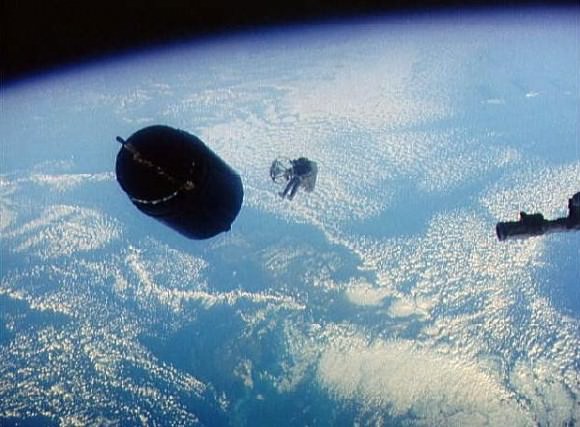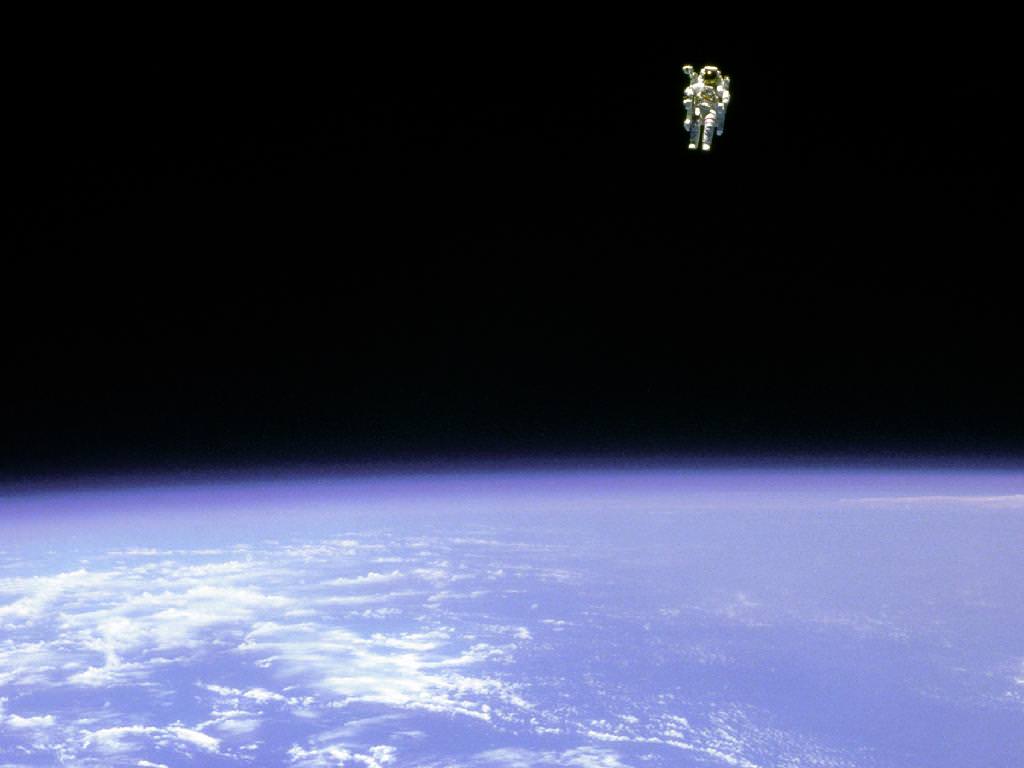[/caption]
28 years ago today, NASA astronaut Bruce McCandless left the relative safety of Challenger’s payload bay and went untethered into orbit around Earth, venturing farther than anyone ever before.
The historic photo above was taken when McCandless was 320 feet from the orbiter — about the length of an American football field, or just shy of the width of the International Space Station.
The free-flying endeavor was possible because of McCandless’ nitrogen-powered jet-propelled backpack, called a Manned Maneuvering Unit (MMU). It attached to the space suit’s life-support system and was operated by hand controls, allowing untethered access to otherwise inaccessible areas of the orbiter and was also used in the deployment, service and retrieval of satellites.

The MMU used a non-contaminating nitrogen propellant that could be recharged in the orbiter. It weighed 140 kg (308 lbs) and has a built-in 35mm camera.
After the Challenger disaster, the MMU was deemed too risky and was discontinued. But for a brief period of time in the early ’80s, humans had the means for really “soaring to new heights”.


It is amazing that this is already 28 years ago
If walking on the moon is a 10 then this is a 9.5 and change. How utterly amazing, thrilling, terrifying and exhilerating that would be.
Imagine being a football length away and then being hit by a micro meteorite that pushed you far enough away where you lost the station or you ran out of propellent trying to get back? Scary!
You don’t use propellent continuously. It is used in small, short, gentle bursts to get you moving in the right direction. Once moving, nothing is going to stop you. Continuous use of propellent would just increase your velocity. Sounds like fun to me – especially with the new suits that don’t make you look like the Sta-Puft Marshmallow Man.
A micrometeorite would never imbue enough momentum in an astronaut to cause such a problem… and even if it did, a far bigger problem would be the impact damage caused – chances are the astronaut would be dead before he noticed he had an inappropriate velocity.
Thinking of being in his shoes, unteathered and a football field length away from the orbiter… damn near gives me a panic attack.
No more frightening than skydiving from 12,000 feet really. It’s a question of training and faith in the equipment. But I know what you mean. De-orbiting wouldn’t be a pleasant prospect! And neither would be running out of air. Yeow! Now I’m on the verge of a panic attack.
Ah, those were indeed the days! That’s why it’s so hard to get back to the moon these days, other than no budget. Everything is too risky and open to costly litigation. Everything has to be tested to the umpth degree. I wonder whether the boys on Apollo 13 spoke to lawyers within 3 minutes of touching down.
On another tack, what an awesome photo! THAT is what is exciting about space! Seeing a man doing something other than sucking water droplets up a straw!
Maybe we should use prisoners. It goes into ethical things, but we should go forward more quickly. We couldn’t probably use people who killed many people. There must be people willing to die for great things.
I’m not sure if I’d want to look at historic photos of space exploration and know that they were all criminals. Kinda ruins the moment.
Who needs prisoners? (Who won’t be all that motivated to cooperate.) If you could throw the process wide open, you’d have *plenty* of volunteers…especially among the ‘extreme’ (an ungodly overused word now) sports crowd.
We could use bankers and lawyers instead of prisoners.
These are educated people and we have enough of them!
So, instead of leeching of “the system” they could (if they have the “right stuff”)
do good for the society that they have done so very well from.
Or how about some of those pesky politicians. What a photo op!
I would imagine that the agreements astronauts have with their employers are along the same lines as soldiers have with their employers – effectively waivering any rights to recompense if they’re “killed in action”.
Pure speculation, but I would be surprised if this wasn’t the case.
@Scott – maybe more like 9.99!
I was always surprised & disappointed that the MMU was considered too risky for someone who has already strapped himself into an airframe attached to 2 SRBs and ridden it into orbit.
I suppose it’s a case of weighing necessities. If you want someone in orbit, strapping them to rockets is absolutely necessary. But having them float around in an MMU when robots can now mostly do the work required is an unnecessary risk.
Of course, I’m assuming that putting people in orbit is necessary in the first place… and some would argue it’s not when robotics is so much more advanced than it used to be. But I guess banning Americans from space altogether is not politically expedient.
Still, there’s something to be said about the Buck Rogers image of strapping on a rocket pack and flying free.
Anyone remembers old computer game called Jet Pack? 😀
Chilling picture.
28 years eh!!! Sadly, we have not gone much further, except in movies — Deep Impact, Armageddon! Sorry, science guys, not complaining ;-), but then there it is ;-(
Amazing, exhilarating beyond belief and I imagine just plain terrifying if you let it be… BTW, Kudos for the Bowie ref in the article headline!!
Yep, “Planet Earth is blue, and there’s nothing I can do….”
Scary but nice picture! This astronaut is very brave!